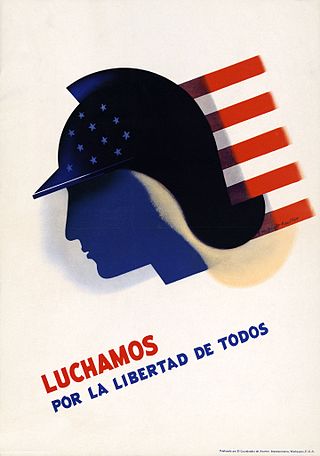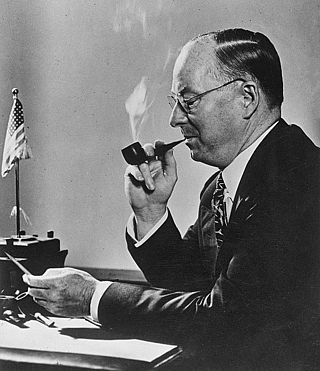
Henry Agard Wallace was an American politician, journalist, farmer, and businessman who served as the 33rd vice president of the United States, under President Franklin D. Roosevelt. He served as the 11th U.S. Secretary of Agriculture and the 10th U.S. Secretary of Commerce. He was the nominee of the new Progressive Party in the 1948 presidential election.

William Harrison Standley was an admiral in the United States Navy, who served as Chief of Naval Operations from 1933 to 1937. He also served as the U.S. ambassador to the Soviet Union from 1941 until 1943.

The United States Office of Personnel Management (OPM) is an independent agency of the United States government that manages the US civilian service. The agency provides federal human resources policy, oversight, and support, and tends to healthcare (FEHB), life insurance (FEGLI), and retirement benefits for federal government employees, retirees, and their dependents.
The United States maintained its Constitutional Republic government structure throughout World War II. Certain expediencies were taken within the existing structure of the Federal government, such as conscription and other violations of civil liberties, including the internment and later dispersal of Japanese-Americans. Still, elections were held as scheduled in 1944.

The War Production Board (WPB) was an agency of the United States government that supervised war production during World War II. President Franklin D. Roosevelt established it in January 1942, with Executive Order 9024. The WPB replaced the Supply Priorities and Allocations Board and the Office of Production Management.
The Office of Administrator of Export Control was established in the United States by Presidential Proclamation 2413, July 2, 1940, to administer export licensing provisions of the act of July 2, 1940. Brigadier General Russell Lamont Maxwell, United States Army, headed up this military entity. It was abolished by Presidential Executive Order 8900, September 15, 1941, and its functions were transferred to the Economic Defense Board, which had been established by Presidential Executive Order 8839, July 30, 1941, to develop policies and programs to strengthen U.S. international economic relations. The name was changed to Board of Economic Warfare by Presidential Executive Order 8982, December 17, 1941. In turn, it was abolished by Executive Order 9361, July 15, 1943, and the functions were transferred to the newly created Office of Economic Warfare, OEM, which also assumed control of U.S. Commercial Company, Rubber Development Corporation, Petroleum Reserves Corporation, and Export-Import Bank of Washington from the Reconstruction Finance Corporation. Consolidated into the Foreign Economic Administration, 1943.

The Office of the Coordinator of Inter-American Affairs, later known as the Office for Inter-American Affairs, was a United States agency promoting inter-American cooperation (Pan-Americanism) during the 1940s, especially in commercial and economic areas. It was started in August 1940 as OCCCRBAR with Nelson Rockefeller as its head, appointed by President Franklin Delano Roosevelt.

William Signius Knudsen was a leading Danish-American automotive industry executive and an American general during World War II. His experience and success as a key senior manager in the operations sides of Ford Motor Company and then General Motors led the Franklin Roosevelt administration to commission him directly as a lieutenant general in the United States Army to help lead the United States' war materiel production efforts for World War II.
Headed by Victor Perlo, the Perlo group is the name given to a group of Americans who provided information which was given to Soviet intelligence agencies; it was active during the World War II period, until the entire group was exposed to the FBI by the defection of Elizabeth Bentley.

The Truman Committee, formally known as the Senate Special Committee to Investigate the National Defense Program, was a United States Congressional investigative body, headed by Senator Harry S. Truman. The bipartisan special committee was formed in March 1941 to find and correct problems in US war production with waste, inefficiency, and war profiteering. The Truman Committee proved to be one of the most successful investigative efforts ever mounted by the U.S. government: an initial budget of $15,000 was expanded over three years to $360,000 to save an estimated $10–15 billion in military spending and thousands of lives of U.S. servicemen. For comparison, the entire cost of the simultaneous Manhattan Project, which created the first atomic bombs, was $2 billion. Chairing the committee helped Truman make a name for himself beyond his political machine origins and was a major factor in the decision to nominate him as vice president, which would propel him to the presidency after the death of Franklin D. Roosevelt.

Amory Houghton served as United States Ambassador to France from 1957 to 1961 and as national president of the Boy Scouts of America. He was chairman of the board of Corning Glass Works (1941–1961). In 1959 he was elected as an honorary member of the New York Society of the Cincinnati.

Donald Marr Nelson (1888–1959) was an American business executive and public servant, serving as the executive vice president of Sears Roebuck before accepting the position of director of priorities of the United States Office of Production Management (1941–1942). In 1942 Nelson became chairman of the War Production Board (1942–1944) when it replaced the OPM. He later served for two years (1945–1947) as president of the Society of Independent Motion Picture Producers.
The Fair Employment Practice Committee (FEPC) was created in 1941 in the United States to implement Executive Order 8802 by President Franklin D. Roosevelt "banning discriminatory employment practices by Federal agencies and all unions and companies engaged in war-related work." That was shortly before the United States entered World War II. The executive order also required federal vocational and training programs to be administered without discrimination. Established in the Office of Production Management, the FEPC was intended to help African Americans and other minorities obtain jobs in home front industries during World War II. In practice, especially in its later years, the committee also tried to open up more skilled jobs in industry to minorities, who had often been restricted to lowest-level work. The FEPC appeared to have contributed to substantial economic improvements among black men during the 1940s by helping them gain entry to more skilled and higher-paying positions in defense-related industries.

Captain Allen Bevins Reed was a U.S. Naval officer whose career began aboard vessels in the Asiatic and Pacific Fleets. Early in his career he was Captain Takeshita Isamu's escort during a ceremonial visit to the mayor of San Francisco, and he was a member of a Naval Board of Inquiry. Reed assumed the command of a landing force of 120 men in Nicaragua in 1912, to protect a railway line following a coup d'état attempt by General Luis Mena.

The War Food Administration was a United States government agency that existed from 1943 to 1945. The War Food Administration was responsible for the production and distribution of food to meet war and essential civilian needs during World War II. It was a predecessor of the Farm Service Agency.
The Combined Production and Resources Board was a temporary World War II government agency that allocated the combined economic resources of the United States and Britain. It was set up by President Franklin D. Roosevelt and Prime Minister Winston Churchill on June 9, 1942. Canada, after insisting on its economic importance, was given a place on the board in November, 1942. The Board closed down at the end of December 1945.

The Combined Munitions Assignments Board was a major government agency for the U.S. and Britain in World War II. With Harry Hopkins, Roosevelt's top advisor in charge, it took control of the allocation of war supplies and Lend lease aid to the Allies, especially Britain and the Soviet Union.

Katherine L. Archuleta is an American teacher and a political executive. She was the director of the United States Office of Personnel Management. President Barack Obama appointed her on May 23, 2013. She was sworn in on November 4, 2013. She had previously served as National Political Director for Obama's 2012 reelection campaign. Prior to that, she had been executive director of the National Hispanic Cultural Center Foundation in New Mexico, had co-founded the Latina Initiative, had worked at a Denver law firm, and had worked in the Clinton Administration as chief of staff to the Secretary of Transportation, Federico Peña. She became embroiled in controversy after the disclosure of a massive national security breach in June 2015. The hack involved the theft of millions of federal employee records and included security-clearance details dating back 15 years, which prompted lawmakers from both political parties to demand that she resign. On July 10, 2015, Archuleta tendered her resignation.

The third presidential term of Franklin D. Roosevelt began on January 20, 1941, when he was once again inaugurated as the 32nd president of the United States, and the fourth term of his presidency ended with his death on April 12, 1945. Roosevelt won a third term by defeating Republican nominee Wendell Willkie in the 1940 United States presidential election. He remains the only president to serve for more than two terms. Unlike his first two terms, Roosevelt's third and fourth terms were dominated by foreign policy concerns, as the United States became involved in World War II in December 1941.
The Office of Production Management was a United States Government agency that existed from January 1941 to centralize direction of the federal procurement programs and quasi-war production during the period immediately proceeding the United States' involvement in World War II. After the United States formally entered World War II, the War Production Board superseded the Office of Production Management in January 1942 and the office ceased to exist shortly thereafter. It was established and distestablished by Executive Order of President Franklin D. Roosevelt.














